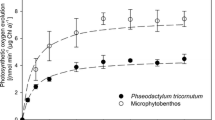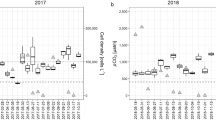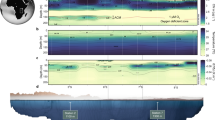Abstract
Aquatic research on primary production and carbon dynamics often ignores calcification that supports photosynthesis by producing protons and forming CO2. Calcification prevents detrimental pH rise, but causes greater decrease of dissolved inorganic carbon (DIC). Concurrent DIC replenishment is therefore essential to maintain high photosynthesis. Here we show a mean daily DIC loss of 40% (26% to photosynthesis and 14% to calcification) in surface waters during summer periods in a shallow charophyte-lake and replenishment of the DIC pool by respiration and carbonate dissolution in the bottom waters followed by nocturnal mixing. The daytime DIC assimilation in organic matter relative to oxygen production in surface waters was close to 1.0 (molar ratio), while total DIC loss markedly exceeded oxygen production because of calcification. Our results suggest that photosynthesis would rapidly become carbon limited if permanent stratification prevented transfer of DIC from bottom waters to surface waters or if permanent mixing prevented CO2 accumulation conducive to carbonate dissolution in bottom waters. This vertical transport of DIC effectively functions as a physical and biological pump supporting high metabolism in charophyte-dominated shallow lakes with recurring daily stratification and mixing.







Similar content being viewed by others

Change history
07 February 2019
In the original publication, the subscript number 2 were incorrectly added without the subscript format as ‘CO2’ and ‘O2’ in Figs. 4 and 5 legends.
References
Andersen MR, Sand-Jensen K, Iestyn Woolway R, Jones ID (2016) Profound daily vertical stratification and mixing in a small, shallow, wind-exposed lake with submerged macrophytes. Aquat Sci. https://doi.org/10.1007/s00027-016-0505-0
Andersen MR, Kragh T, Sand-Jensen K (2017) Extreme diel dissolved oxygen and carbon cycles in shallow vegetated lakes. Proc R Soc B Biol Sci. https://doi.org/10.1098/rspb.2017.1427
Barnes DJ (1970) Coral skeletons: an explanation of their growth and structure. Science 170:1305–1308
Biggs J, von Fumetti S, Kelly-Quinn M (2017) The importance of small waterbodies for biodiversity and ecosystem services: implications for policy makers. Hydrobiologia. https://doi.org/10.1007/s10750-016-3007-0
Boehrer B, Schultze M (2008) Stratification of lakes. Rev Geophys 46(2):1–27. https://doi.org/10.1029/2006RG000210
Brunskill G (1969) Fayetteville Green Lake, New York. II. Precipitation and sedimentation of calcite in a meromictic lake with laminated sediments. Limnol Oceanogr 14:830–847
Chauvaud L, Thompson JK, Cloern JE, Thouzeau G (2003) Clams as CO2 generators: the Potamocorbula amurensis example in San Francisco Bay. Limnol Oceanogr 48:2086–2092
Christensen J, Sand-Jensen K, Staehr PA (2013) Fluctuating water levels control water chemistry and metabolism of a charophyte-dominated pond. Freshw Biol 58:1353–1365. https://doi.org/10.1111/fwb.12132
Cole JJ, Caraco NF (1998) Atmospheric exchange of carbon dioxide in a low-wind oligotrophic lake measured by the addition of SF6. Limnol Oceanogr 43:647–656
Cole JJ, Prairie YT, Caraco NF, McDowell WH, Tranvik LJ, Striegl RG, Duarte CM, Kortelainen P, Downing JA, Middelburg JJ, Melack JM (2007) Plumbing the global carbon cycle: integrating inland waters into the terrestrial carbon budget. Ecosystems 10:172–185
Cole JJ, Bade DL, Bastviken D, Pace ML, Van de Bogert M (2010) Multiple approaches to estimating air-water gas exchange in small lakes. Limnol Oceanogr Methods 8:285–293
Downing JA, Prairie YT, Cole JJ, Duarte CM, Tranvik LJ, Striegl RG, McDowell WH, Kortelainen P, Caraco NF, Melack JM (2006) The global abundance and size distribution of lakes, ponds, and impoundments. Limnol Oceanogr 51:2388–2397
Golléty C, Gentil F, Davoult D (2008) Secondary production, calcification and CO2 fluxes in the cirripedes Chthamalus montagui and Elminius modestus. Oecologia 155:133–142
Gorham E, Boyce FM (1989) Influence of lake surface area and depth upon thermal stratification and the depth of the summer thermocline. J Great Lakes Res 15:233–245
Gran G (1952) Determination of the equivalence point in potentiometric titrations-part II. Analyst 77:661–671
Hotchkiss ER, Hall RO (2010) Linking calcification by exotic snails to stream inorganic carbon cycling. Oecologia 163:235–244
Kalff J (2002) Limnology: inland water ecosystems. Prentice Hall, New Jersey
Kragh T, Sand-Jensen K (2018) Carbon limitation of lake productivity. Proc R Soc B 285:20181415
Kragh T, Andersen MR, Sand-Jensen K (2017) Profound afternoon depression of ecosystem production and nighttime decline of respiration in a macrophyte-rich, shallow lake. Oecologia 185:157–170
Kufel L, Kufel I (2002) Chara beds acting as nutrient sinks in shallow lakes—a review. Aquat Bot 72:249–260
Lewis E, Wallace D (1998) Program developed for CO2 System Calculations (Carbon Dioxide Information Analysis Center, Oak Ridge National Laboratory, US Dept. of Energy, Oak Ridge, TN). ORNL/CDIAC-105
Marcé R, Obrador B, Morguí J-A, Riera JL, López P, Armengol J (2015) Carbonate weathering as a driver of CO2 supersaturation in lakes. Nat Geosci 8:107
Martinsen KT, Andersen MR, Kragh T, Sand-Jensen K (2017) High rates and close diel coupling of primary production and ecosystem respiration in small, oligotrophic charophyte-rich lakes. Aquat Sci 79:995–1007
Martinsen KT, Andersen MR, Sand-Jensen K (2019) Water temperature dynamics and the prevalence of daytime stratification in small, shallow lakes. Hydrobiologia 826:247–262
McConnaughey T (1991) Calcification in Chara corallina: CO2 hydroxylation generates protons for bicarbonate assimilation. Limnol Oceanogr 36:619–628
McConnaughey T, Whelan J (1997) Calcification generates protons for nutrient and bicarbonate uptake. Earth Sci Rev 42:95–117
McConnaughey TA, LaBaugh JW, Rosenberry DO, Striegl RG, Reddy MM, Schuster PF, Carter V (1994) Carbon budget for a groundwater-fed lake: calcification supports summer photosynthesis. Limnol Oceanogr 39:1319–1332
Müller B, Meyer JS, Gächter R (2016) Alkalinity regulation in calcium carbonate-buffered lakes. Limnol Oceanogr 61:341–352
Nielsen ES (1952) The use of radio-active carbon (C14) for measuring organic production in the sea. Journal de Conseil 18:117–140
Nõges P, Cremona F, Laas A, Martma T, Rõõm E-I, Toming K, Viik M, Vilbaste S, Nõges T (2016) Role of a productive lake in carbon sequestration within a calcareous catchment. Sci Total Environ 550:225–230
Peeters F, Atamanchuk D, Tengberg A, Encinas-Fernández J, Hofmann H (2016) Lake metabolism: comparison of lake metabolic rates estimated from a diel CO2- and the common diel O2-technique. PLoS One 11:e0168393
Plummer LN, Busenberg E (1982) The solubilities of calcite, aragonite and vaterite in CO2–H2O solutions between 0 and 90 C, and an evaluation of the aqueous model for the system CaCO3–CO2–H2O. Geochimica et cosmochimica acta 46:1011–1040
Prins H, Snel J, Helder R, Zanstra P (1979) Photosynthetic bicarbonate utilization in the aquatic angiosperms Potamogeton and Elodea. Hydrobiol Bull 13:106–111
Quay P, Emerson S, Quay B, Devol AH (1986) The carbon cycle for Lake Washington—a stable isotope study. Limnol Oceanogr 31:596–611
Raymond PA, Zappa CJ, Butman D, Bott TL, Potter J, Mulholland P, Laursen AE, McDowell WH, Newbold D (2012) Scaling the gas transfer velocity and hydraulic geometry in streams and small rivers. Limnol Oceanogr Fluids Environ 2:41–53
Read JS, Hamilton DP, Jones ID, Muraoka K, Winslow LA, Kroiss R, Wu CH, Gaiser E (2011) Derivation of lake mixing and stratification indices from high-resolution lake buoy data. Environ Model Softw 26:1325–1336
Sand-Jensen KAJ (1983) Photosynthetic carbon sources of stream macrophytes. J Exp Bot 34(2):198–210
Sand-Jensen K, Jespersen TS (2012) Tolerance of the widespread cyanobacterium Nostoc commune to extreme temperature variations (− 269 to 105 C), pH and salt stress. Oecologia 169:331–339
Sand-Jensen K, Jensen RS, Gomes M, Kristensen E, Martinsen KT, Kragh T, Baastrup-Spohr L, Borum J (2018) Photosynthesis and calcification of charophytes. Aquat Bot 149:46–51. https://doi.org/10.1016/j.aquabot.2018.05.005
Schindler D, Fee E (1974) Experimental lakes area: whole-lake experiments in eutrophication. J Fisheries Board Canada 31:937–953
Stabel HH (1986) Calcite precipitation in Lake Constance: chemical equilibrium, sedimentation, and nucleation by algae. Limnol Oceanogr 31:1081–1094
Standard, Methods (1971) Standard methods for examination of water and wastewater, 13th edn. American Public Health Association, New York
Stumm W, Morgan JJ (1970) Aquatic chemistry; an introduction emphasizing chemical equilibria in natural waters. Wiley, New York, p 583
Tranvik LJ, Downing JA, Cotner JB, Loiselle SA, Striegl RG, Ballatore TJ, Dillon P, Finlay K, Fortino K, Knoll LB (2009) Lakes and reservoirs as regulators of carbon cycling and climate. Limnol Oceanogr 54:2298–2314
van den Berg MS, Coops H, Simons J, Pilon J (2002) A comparative study of the use of inorganic carbon resources by Chara aspera and Potamogeton pectinatus. Aquat Bot 72:219–233
Verpoorter C, Kutser T, Seekell DA, Tranvik LJ (2014) A global inventory of lakes based on high-resolution satellite imagery. Geophys Res Lett 41:6396–6402
Wanninkhof R, Knox M (1996) Chemical enhancement of CO2 exchange in natural waters. Limnol Oceanogr 41:689–697
Wetzel RG (2001) Limnology: lake and river ecosystems. Gulf Professional Publishing, Houston
Weyhenmeyer GA, Kortelainen P, Sobek S, Müller R, Rantakari M (2012) Carbon dioxide in boreal surface waters: a comparison of lakes and streams. Ecosystems 15:1295–1307
Author information
Authors and Affiliations
Corresponding author
Additional information
Publisher’s Note
Springer Nature remains neutral with regard to jurisdictional claims in published maps and institutional affiliations.
Electronic supplementary material
Below is the link to the electronic supplementary material.
Rights and permissions
About this article
Cite this article
Andersen, M.R., Kragh, T., Martinsen, K.T. et al. The carbon pump supports high primary production in a shallow lake. Aquat Sci 81, 24 (2019). https://doi.org/10.1007/s00027-019-0622-7
Received:
Accepted:
Published:
DOI: https://doi.org/10.1007/s00027-019-0622-7



